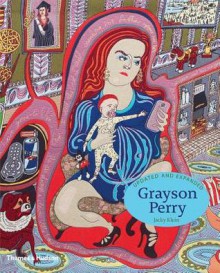
So, I dunno what the formal definition is, but if you'd asked me what mine is, I'd say conceptual art is art you don't need to see. That is, if someone just tells you about it, you gain nothing by actually then going and looking at it. Examples would be Equivalent VII, which is a pile of bricks (not bricks in a particularly pleasing arrangement, just a boring set of bricks on the floor) or Piss Christ, which is a crucifix in a glass jar full of urine. The former just says, "Anything I call art is art because I say so, because I'm artist." The latter says, "I can't be bothered to do anything artistic so I'm just going to try to shock you." Wasting time/money going to see either does not benefit one once you've been told about them. Contrast with The Haywain - hearing it described doesn't remotely replace actually seeing it.
But Perry Grayson fairly aggressively claims to be a conceptual artist in the early part of this book and there is definitely more to be gained from seeing his work than just hearing it described. This made me think a bit and I concluded that there's a kind of second tier of highly intellectual art that nevertheless benefits the viewer's time and attention. This doesn't make it worse, in my view (quite the opposite) but it's art that isn't purely a concept that doesn't need to be physically present to achieve its aims. Later in the book, Perry very much lays claim to the craft of his work (mainly pottery) which also runs counter to my notions of conceptual art, as does the extensive social, religious and political commentary and autobiographical content. He talks about not liking the idea of an artist who merely has the idea and gets his "assistants" to actually make it. (Damien Hirst gets called out in this context.)
Perry's work is typically very dense with imagery, some of which is recurring across many pieces, becoming a personal iconography and because usually a continuous surface in three dimensional space, photos struggle somewhat to capture everything. Actually seeing a Perry pot is the best way to appreciate it - the antithesis of my definition of conceptual art. On the other hand, Perry's own commentary on the work is extremely helpful in understanding what is going on in it and often times more interesting than the actual object - veering back towards the conceptual.
The book itself is a thorough and comprehensive look at Perry's career, divided into thematic sections but also illustrating Perry's changing attitudes as he has grown older and I can highly recommend it if you are interested in his work.

 Log in with Facebook
Log in with Facebook 





